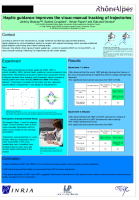Jérémy Bluteau
Contact
Information
Short Bio
Welcome to my professional webpage.
I'm currently a PhD engineer. My thesis work (2006-2010) was located at INRIA Rhones-alpes, TIMC and LPNC, at the border between three scientific domains.
My research interests included the design of haptics virtual environments in relation with medecine applications and the understanding of haptic perception.
This interest for haptic and for medical applications came from several previous experiences. I graduated from Polytech'Grenoble, T.I.S (Information Technology for Health) in 2006. I have also worked on Virtual Reality and Medical Applications (Visual See-Through Medical Examination) in Tsukuba, Japan, with Prof. Yuichi Sato, Itaru Kitahara and Yoshinari Kameda. Then, I persevered in this way by working on an Haptic Laparoscopic Simulator with Clement Forest, Luc Soler at Prof. Jacques Marescaux's institute : IRCAD (Research Institute against Digestive Cancer).
What's New (07/11/10 )
Research
My thesis is about the "Evaluation of
the effects on control of the manual gesture of the addition of haptic
interfaces ".
I share my time within three laboratories : TIMC (Techniques de l'Imagerie, de la
Modélisation et de la Cognition), LPNC (Laboratoire de Psychologie et Neuro
Cognition) et INRIA-GRAVIR-LIG(Institut National de Recherche en
informatique et en Automatique).
- LPNC is a team, mainly
concentrated on studies of mental functions, particullaly haptic
perception. This team has a real expert knowledge concerning human
experimentations.
- Finally, as a part of
INRIA, the i3D
team is an augmented/virtual reality research team, dealing with 3D
interactions. This team has several virtual reality systems : a virtual
reality workbench, Omni, PhanTom, Spidar, Head Monted Display,...
This thesis in realized in a doctoral school of INPG(Institut
National Polytechnique de Grenoble).
Teaching
Publications, Poster & Communications
Publications

|
Vibrotactile Guidance for Trajectory Following in Computer Aided Surgery
Abstract
Most conventional computer-aided navigation sys- tems assist the surgeon visually by tracking the position of an ancillary and by superposing this position into the 3D preoperative imaging exam. This paper aims at adding to such navigation systems a device that will guide the surgeon towards the target, following a complex preplanned ancillary trajectory. We propose to use tactile stimuli for such guidance, with the design of a vibrating belt. An experiment using a virtual surgery simulator in the case of skull base surgery is conducted with 9 naive subjects, assessing the vibrotactile guidance effectiveness for complex trajectories. Comparisons between a visual guidance and a visual+tactile guidance are encouraging, supporting the relevance of such tactile guidance paradigm.
|

|
Short paper: Role of force-cues in path following of 3D trajectories in Virtual Reality
 Bibtex
Bibtex
Abstract
This paper examines the effect of adding haptic force cues (simulated inertia, compensation of gravity) during 3D-path following in large immersive virtual reality environments. Thirty-four participants were asked to follow a 3D ring-on-wire trajectory. The experiment consisted of one pre-test/control bloc of twelve trials with no haptic feedback; followed by three randomized blocs of twelve trials, where force feedbacks differed. Two levels of inertia were proposed and one level compensating the effect of gravity (No-gravity). In all blocks, participants received a real time visual warning feedback (color change), related to their spatial performance. Contrariwise to several psychophysics studies, haptic force cues did not significantly change the task performance in terms of time completion or spatial distance error. The participants however significantly reduced the time passed in the visual warning zone in the presence of haptic cues. Taken together, these results are discussed from a psychophysics and multi-sensory integration point of view.
|
Talk

|
ICP 2008 - International congress of Psychology - BERLIN - 20-25 July 2008 : Haptic guidance improve the visuo-manual tracking of ellipses drawing in adults (invited talk)
 Telecharger la présentation
Telecharger la présentation
|
Posters
Communications
|
This
material is presented to ensure timely
dissemination of scholarly and technical work. Copyright and all rights
therein are retained by authors or by other copyright holders. All
persons copying this information are expected to adhere to the terms
and constraints invoked by each author's copyright. In most cases,
these works may not be reposted without the explicit permission of the
copyright holder.
Last update:
07/11/10
|
|



 Bibtex
Bibtex

 Bibtex
Bibtex
 http://www.techniques-ingenieur.fr/book/re131/apprendre-a-ecrire---apports-des-interfaces-haptiques.html
http://www.techniques-ingenieur.fr/book/re131/apprendre-a-ecrire---apports-des-interfaces-haptiques.html

 Bibtex
Bibtex
 http://cat.inist.fr/?aModele=afficheN&cpsidt=20615897
http://cat.inist.fr/?aModele=afficheN&cpsidt=20615897

 Telecharger la publication
Telecharger la publication
 Bibtex
Bibtex

 Telecharger la publication
Telecharger la publication
 Bibtex
Bibtex
 http://doi.acm.org/10.1145/1152399.1152418
http://doi.acm.org/10.1145/1152399.1152418

 Telecharger la présentation
Telecharger la présentation
 Telecharger le poster
Telecharger le poster Telecharger l'abstract
Telecharger l'abstract Bibtex
Bibtex

 Telecharger le poster
Telecharger le poster
 Telecharger le poster
Telecharger le poster
 Telecharger le communiqué
Telecharger le communiqué http://www.innovationlejournal.fr/spip.php?article2810&var_recherche=stylo
http://www.innovationlejournal.fr/spip.php?article2810&var_recherche=stylo

 Telecharger le communiqué
Telecharger le communiqué http://france-science.org/Un-outil-de-la-realite-virtuelle
http://france-science.org/Un-outil-de-la-realite-virtuelle

 Telecharger le communiqué
Telecharger le communiqué http://www.grenoble-universites.fr/1207295071174/0/fiche___actualite/&RH=GUGIP
http://www.grenoble-universites.fr/1207295071174/0/fiche___actualite/&RH=GUGIP

 Telecharger le communiqué
Telecharger le communiqué http://www.ledauphine.com/ecriture-quatre-chercheurs-ont-developpe-un-systeme-robotise-qui-aide-a-mieux-calligraphier-l-arabe-et-le-japonais-au-bout-du-stylo-robot-@/index.jspz?chaine=25&article=16545
http://www.ledauphine.com/ecriture-quatre-chercheurs-ont-developpe-un-systeme-robotise-qui-aide-a-mieux-calligraphier-l-arabe-et-le-japonais-au-bout-du-stylo-robot-@/index.jspz?chaine=25&article=16545

 Telecharger le communiqué
Telecharger le communiqué http://www.cnrs.fr/sdv/recherche/parutions/articles08/bluteau.htm
http://www.cnrs.fr/sdv/recherche/parutions/articles08/bluteau.htm